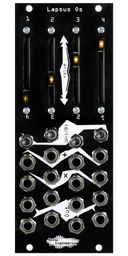Many fixed-architecture synthesizers feature different ways to control various parts of their interfaces – mod wheels, touch plates, you name it. Since Eurorack is modular, we can decide exactly how we want to control our patches – but what controllers are right for you, and how can we patch them up to work their best? Today, we’ll discuss a few common types of controllers and how they can be implemented into your patches.
External keyboards
Playing your Eurorack system with a keyboard can be a great way to create a custom monosynth that sounds exactly how you like. I have a few voices in my system that I particularly enjoy, and sometimes I’ll patch up my Keystep 37’s CV/gate outputs for a jam.

If you want to use a keyboard with your system, you’ll need a set of pitch CV and gate outputs to control your voices. Some keyboards have analog voltage outputs built in; if yours doesn’t, you’ll need a MIDI to CV converter to control your patch. Additional controls, like velocity or aftertouch, can be useful in a patch, too; some keyboards have these as CV outputs, and most will output CCs for that sort of thing if you go the MIDI route.

External sequencers are also a great tool to consider. Some output CV/gate signals themselves, while others only output MIDI. You can integrate a MIDI sequencer with a MIDI to CV converter the same way you’d use a MIDI keyboard.
One of the first sequencers I used with my system was an Arturia BeatStep Pro: it had a great percussion sequencer that I used to sequence my drum voices, as well as a melodic voice. I know a lot of folks that utilize Elektron gear, like the Syntakt or Octatrack, as the sequencers for their systems utilizing their extensive MIDI control. External gear like this can be a great option for smaller systems, or if you just like the variety of having some non-Eurorack hardware in your setup.
Offsets/attenuators
Within the rack, there are a huge number of control modules that simply act as attenuators and/or offsets with different interfaces. Our Lapsus Os is a good example: it has four channels, controlled by sliders, that can create DC offsets or attenuate external signals.
An offset paired with a mult is a great way to create a macro control in your patch. For example, I could patch a single channel of Lapsus Os through a mult and into the decay CV inputs of all of my drum voices, creating a dramatic change whenever I adjusted the slider.

A similar concept is true for attenuated signals. For example, if I could route an LFO through a performable attenuator and a mult. Then, I could patch it to a few CV destinations and bring movement in and out with a single control.
Another common DC source is a touch controller, like the Make Noise PrssPnt or Bela.io Gliss. This generates CV based on how you press on a point on the panel, which can be a fun and organic way to control a patch. I like to use these sorts of controllers on timbral CV destinations; for example, if I patch the output to a wavefolder’s CV input, the resulting sound will be brighter or darker depending on how I press the panel.
Joysticks – like the Doepfer A-174-4 and Intellijel Planar 2– are another fun DC source (with some offering attenuation, too). They often have a CV output for each axis, so they’re easy to patch similarly to any other control module. Some even offer quadraphonic-panning inputs and outputs, if you’re a fan of multi-speaker setups.
Programmers
Taking a seat somewhere between a sequencer and an offset generator, programmers, like Harlequin’s Context or Total Recall, generally offer a few CV outputs that can recall different values at the press of a button. Programmers are great if you need to change a few settings at once, or want to jump between dialed-in values during a performance. Often, I’ll use a programmer module to swap between voice settings on the BIA by patching to the Mode CV and a few timbral controls: one “preset” is a kick drum, another a snare, another a zap… Presets aren’t usually a thing in Eurorack, especially with analog modules – but anything that can be CV controlled can have a number of stored values with the help of a programmer module.
Some programmers can be used similarly to keyboards within the rack, too. A channel of a programmer like the Make Noise Pressure Points could be run through a quantizer to behave like a small keyboard.
Mutes and switches
A final controller-adjacent module is the manually-controlled switch. Simple switches, like Muta Jovis, are designed to simply mute or unmute a signal. More complex switches, like the Doepfer A-182-2 or A-182-4, have multiple inputs and outputs that can be selected with a single control. I use mutes extensively in my patches to bring voices in and out of a performance, and use routing switches to switch between sequencers in larger patches.









